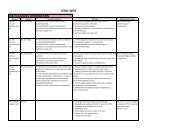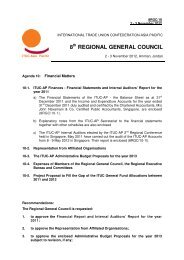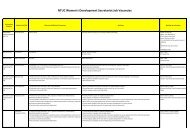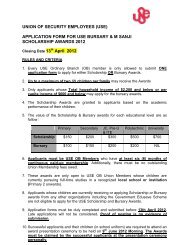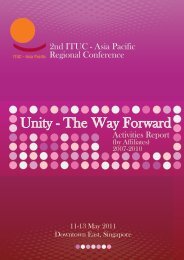BANGLADESH LABOUR LAW: - People Tree Foundation
BANGLADESH LABOUR LAW: - People Tree Foundation
BANGLADESH LABOUR LAW: - People Tree Foundation
You also want an ePaper? Increase the reach of your titles
YUMPU automatically turns print PDFs into web optimized ePapers that Google loves.
The Government shall appoint a Chief Inspectors and requisite number of Deputy Chief<br />
Inspectors, Assistant Chief Inspectors or Inspectors. These officers have the power to<br />
enter, inspect and examine any workplace premises and ascertain the observance of<br />
labour laws.<br />
The Government has the power to establish as many Labour Courts as it considers<br />
necessary. A Labour Court shall consist of a chairman and two members (one<br />
representing employers and the other, the workers).<br />
Findings from the Field<br />
As mentioned, this study sought to examine the weaknesses of the labour law system. To find<br />
out what is obtaining on the ground, the research team administered a baseline survey 2 in the<br />
urbanized and industrialized districts of Dhaka, Chittagong, Narayanganj and Gzipur. The<br />
sample survey targeted worker-respondents in the ready-made garments industry (for the formal<br />
sector) and construction industry (for the informal sector). The survey results were supplemented<br />
by 11 worker FGDs in the different districts, case studies and interviews with key informants in<br />
order to come up with a rounded and objective picture of the state of labour law compliance from<br />
the perspective of the ordinary workers.<br />
From the baseline survey, it appears that more than half of the workers have been working for<br />
not more than three years, with over 40 per cent of the workers in the garments industry<br />
registering a work experience of less than a year. This shows the preference of employers for<br />
the short-term hiring of young workers, particularly in the garments industry. In the construction<br />
industry, most of the workers have longer work years of 3-10 years. However, the prevalence of<br />
three types of employment status -- day labourer, contractual labourer and monthly-based<br />
labourer – indicates a high level of employment informality or flexibility in this industry. In fact,<br />
the overwhelming majority of the construction workers are hired through contractors or subcontractors<br />
without the benefit of any employment contracts. Thus, both the garments and the<br />
construction industries employ flexible (meaning easily replaceable) workers.<br />
In general, the research findings show that workers in both the garment and construction<br />
industries are deprived of many of their rights such as the non-issuance of appointment letters<br />
and identity cards, the non-observance of OSH standards and social security provisions, the<br />
limited space for unionism and collective bargaining, and the weak protection provided by the<br />
labour law enforcement and judicial system. Below is a summary of key research findings:<br />
2 A baseline survey questionnaire developed by LO/FTF and ITUC/AP for its affiliates in the Asia-<br />
Pacific region was adopted by the research team, translated into Bangla language and modified to<br />
suit Bangladesh situation after some pre-testing runs.<br />
10








